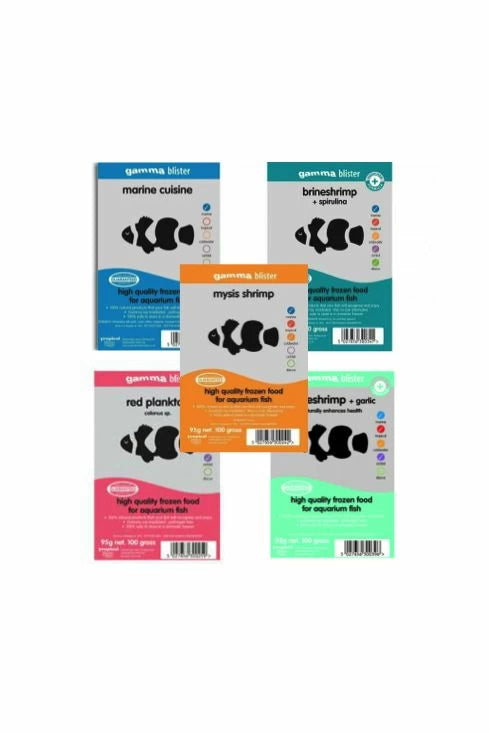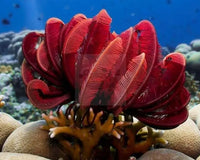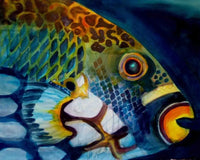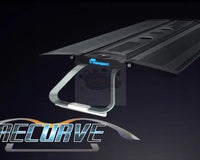How much should I feed my marine fish?
In order to control and reduce waste and ensure all of your fish are getting the food they need, You should only feed what your fish can consume in under 1-2 minutes. If there is leftover food after this time, you are probably adding too much at one time.
It is ok to feed in small amounts but let the fish consume everything within 1-2 minutes, then add some more food if needed or feed again later in the day. It is better to have a few small feedings throughout the day as opposed to one large portion of food. Fish are naturally "opportunistic" feeders meaning they eat whenever food is available to them, usually multiple times per day.
In terms of frequency, you want to accommodate the particular fish in your care based on their natural feeding habits and energy level. Some fish require multiple feedings each and every day, as much as x5 times per day for high-energy fish like Anthias and Chromis, & Damsels. Most aquarists schedule 1-3 small feedings throughout the day, one in the AM and one in the PM but be sure to research the particular fish you have. You can adjust that frequency based on the particular nutritional requirements of your fish and the amount of waste your aquarium can handle.
How do I know my fish are getting enough food?
The easiest way to tell is by looking at your fish's stomach. A skinny fish will have a concave belly and a well-fed fish will have a slightly round belly. In severe cases, you might also notice the definition of the lateral line which means the fat/muscle mass along the body is lacking. A malnourished fish may also act lethargic, show loss of coloration, and can be more susceptible to parasites, infections, and disease.
If you have finicky fish or fish with specialized diets, it's important to accommodate those fish and visually ensure they are consuming the food offerings each and every day. This simple observation of watching all your fish consume food is a great way to verify the health of the animals in your care. A fish that doesn't eat is likely unhealthy or stressed.
How can I tell if I am feeding too much?
This is all about your aquarium's waste or nutrient levels. If nitrate and phosphate levels are constantly rising, you are likely feeding too much or feeding incorrectly. Always turn off your pumps and filtration while feeding your fish to reduce food waste. Be sure your fish are consuming everything you put into the tank in a reasonable amount of time.
If you experience elevated waste levels, be sure to maintain your filtration regularly and perform your water changes to reduce those nutrient levels. Reduce the amount of food you are offering and/or the frequency while also ensuring your fish remain healthy.
A fish will never overeat or "eat themselves to death", this is a silly rumor. The risk that comes with too much food is actually about poisoning the water with excess leftover food.
What kind of food should I use to feed my fish?
High-quality food is the first rule. You want naturally sourced ingredients that are similar to what the fish would consume in the wild. Look to the ingredients list and avoid food with fillers like corn, soy, and wheat. Herbivorous fish need algae and seaweed while carnivorous fish need plenty of meat-based protein from things like shrimp, krill, fish, squid, clams, etc. Omnivorous fish should get a healthy portion of both protein sources Gamma Frozen Foods are 1st choice with Marine World Aquatics.
A reputable food will also provide nutritional analysis. High-quality dry food (flakes and pellets) should have 50% protein and fat content somewhere in the teens. Frozen foods contain a lot of water weight and high-quality frozen food will contain about 12% protein and 2+% fat content.
Particle Size
Ensure the food particles can fit inside your fish's mouth. Watch to ensure the fish are not capturing the food and then spitting it back out which is a sign the food is too big. It's always better to veer on the side of caution and buy smaller foods if you are just not sure.
Food Type
Pellet food should be your #1 choice as a staple food type because you can deliver the most nutrients with each bite. Flake foods can work as well but tend to be messy.
Fresh and/or frozen food should also be used because it will carry additional nutrients and more closely mimic natural food sources. Keep in mind that frozen foods carry some water weight and may introduce additional waste. An aquarium that relies heavily on frozen food requires strong filtration and nutrient export methods to maintain optimal water quality.
Ultimately, variety is important to ensure balanced nutrition so using different types of food is the best possible approach to ensure a complete diet. Accommodating the fish's nutritional requirements is of utmost importance for longevity, color, and resistance to disease.
Do my fish need a variety of foods?
Yes, it is best to offer a variety of foods to your fish. Multi-ingredient frozen foods made using fresh seafood are considered some of the best quality fish foods you can buy and when fed alongside high-quality pellet food, your fish should maintain optimal nutrition without a problem. It's okay to mix different pellet foods together or switch off between feedings so long as your fish are eating what you give them.
You can also use "food soaks" which are liquid supplements that provide valuable vitamins, minerals, and nutrients.
How do I increase the coloration in my fish?
In general, a healthy fish receiving the right nutrition should display the best possible colors. Astaxanthin is a common ingredient used in fish food that is scientifically proven to support red, yellow, and orange coloration among fish. Krill, crayfish, and certain algae species are also intentionally added for the purpose of supporting vibrant coloration. You can source "color-enhancing" foods and look to the ingredients to find out what exactly is being added to promote coloration.
My fish isn't eating, what should I do?
Fish will not eat when they are stressed which is the most common reason. Some fish are more voracious eaters than others but regardless, all your fish need to eat. You may need to train your finicky fish to use a feeding ring or feeding tube to successfully deliver food. Competition for food can be problematic too and you may need to deliver food into the particular area of the tank that different fish inhabit. For example, fish that live on the bottom may only feed off the bottom so laying food on the sand bed is the only way to ensure they get what they need.
It is common for brand new fish to take a couple of days to get used to your aquarium so they may not eat during this time. Exactly why observation and acclimation in a quarantine tank first is the best approach before introducing the fish into your main display. This way you can ensure the fish are eating and free of disease. Ultimately, a fish that doesn't eat after repeated attempts may start to suffer and should be isolated in a quarantine tank. Sometimes removing a fish from the competition is all they need to start eating but it could also be a sign of illness or a parasite that needs treatment.
FEEDING MY MARINE FISH





